Rock (geology)
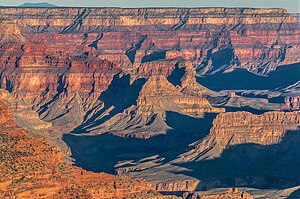
| Part of a series on |
| Geology |
|---|
 |
In geology, rock (or stone) is any naturally occurring solid mass or aggregate of minerals or mineraloid matter. It is categorized by the minerals included, its chemical composition, and the way in which it is formed. Rocks form the Earth's outer solid layer, the crust, and most of its interior, except for the liquid outer core and pockets of magma in the asthenosphere. The study of rocks involves multiple subdisciplines of geology, including petrology and mineralogy. It may be limited to rocks found on Earth, or it may include planetary geology that studies the rocks of other celestial objects.
Rocks are usually grouped into three main groups: igneous rocks, sedimentary rocks and metamorphic rocks. Igneous rocks are formed when magma cools in the Earth's crust, or lava cools on the ground surface or the seabed. Sedimentary rocks are formed by diagenesis and lithification of sediments, which in turn are formed by the weathering, transport, and deposition of existing rocks. Metamorphic rocks are formed when existing rocks are subjected to such high pressures and temperatures that they are transformed without significant melting.
Humanity has made use of rocks since the earliest humans. This early period, called the Stone Age, saw the development of many stone tools. Stone was then used as a major component in the construction of buildings and early infrastructure. Mining developed to extract rocks from the Earth and obtain the minerals within them, including metals. Modern technology has allowed the development of new human-made rocks and rock-like substances, such as concrete.
Study
Geology is the study of Earth and its components, including the study of rock formations. Petrology is the study of the character and origin of rocks. Mineralogy is the study of the mineral components that create rocks. The study of rocks and their components has contributed to the geological understanding of Earth's history, the archaeological understanding of human history, and the development of engineering and technology in human society.[1]
While the history of geology includes many theories of rocks and their origins that have persisted throughout human history, the study of rocks was developed as a formal science during the 19th century. Plutonism was developed as a theory during this time, and the discovery of radioactive decay in 1896 allowed for the radiocarbon dating of rocks. Understanding of plate tectonics developed in the second half of the 20th century.[2]
Classification

Rocks are composed primarily of grains of minerals, which are
Most rocks contain
Rocks are classified according to characteristics such as mineral and chemical composition,
Those three classes are subdivided into many groups. There are, however, no hard-and-fast boundaries between allied rocks. By increase or decrease in the proportions of their minerals, they pass through gradations from one to the other; the distinctive structures of one kind of rock may thus be traced, gradually merging into those of another. Hence the definitions adopted in rock names simply correspond to selected points in a continuously graduated series.[8]
Igneous rock
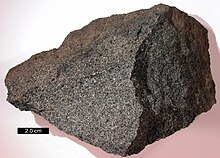
Igneous rock (derived from the Latin word igneus, meaning of fire, from ignis meaning fire)[9] is formed through the cooling and solidification of magma or lava. This magma may be derived from partial melts of pre-existing rocks in either a planet's mantle or crust. Typically, the melting of rocks is caused by one or more of three processes: an increase in temperature, a decrease in pressure, or a change in composition.[10]: 591–599
Igneous rocks are divided into two main categories:
- intrusive rocks result when magma cools and crystallizes slowly within the Earth's crust. A common example of this type is granite.
- Volcanic or
Magmas tend to become richer in silica as they rise towards the Earth's surface, a process called
About 65% of the Earth's crust by volume consists of igneous rocks. Of these, 66% are basalt and
Sedimentary rock

Sedimentary rocks are formed at the earth's surface by the accumulation and cementation of fragments of earlier rocks, minerals, and organisms
Before being deposited, sediments are formed by
Sediment and the particles of clastic sedimentary rocks can be further classified by grain size. The smallest sediments are clay, followed by silt, sand, and gravel. Some systems include cobbles and boulders as measurements.[17]
Metamorphic rock
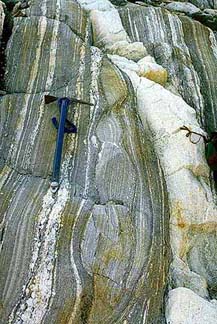
Metamorphic rocks are formed by subjecting any rock type—sedimentary rock, igneous rock or another older metamorphic rock—to different
The three major classes of metamorphic rock are based upon the formation mechanism. An intrusion of magma that heats the surrounding rock causes contact metamorphism—a temperature-dominated transformation. Pressure metamorphism occurs when sediments are buried deep under the ground; pressure is dominant, and temperature plays a smaller role. This is termed burial metamorphism, and it can result in rocks such as jade. Where both heat and pressure play a role, the mechanism is termed regional metamorphism. This is typically found in mountain-building regions.[7]
Depending on the structure, metamorphic rocks are divided into two general categories. Those that possess a texture are referred to as
Extraterrestrial rocks
Though most understanding of rocks comes from those of Earth, rocks make up many of the universe's celestial bodies. In the
Human use
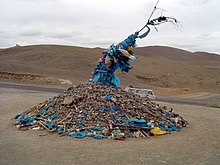
The use of rock has had a huge impact on the cultural and technological development of the human race. Rock has been used by humans and other
marks some of the oldest and continuously used technologies. The mining of rock for its metal content has been one of the most important factors of human advancement, and has progressed at different rates in different places, in part because of the kind of metals available from the rock of a region.Anthropic rock
Anthropic rock is synthetic or restructured rock formed by human activity. Concrete is recognized as a human-made rock constituted of natural and processed rock and having been developed since Ancient Rome.[23] Rock can also be modified with other substances to develop new forms, such as epoxy granite.[24] Artificial stone has also been developed, such as Coade stone.[25] Geologist James R. Underwood has proposed anthropic rock as a fourth class of rocks alongside igneous, sedimentary, and metamorphic.[26]
Building

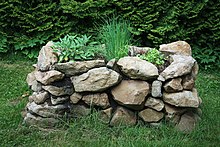
Rock varies greatly in strength, from
Mining
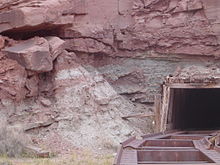
Mining is the extraction of
Mining of rock and metals has been done since prehistoric times. Modern mining processes involve prospecting for mineral deposits, analysis of the profit potential of a proposed mine, extraction of the desired materials, and finally reclamation of the land to prepare it for other uses once mining ceases.[37]
Mining processes may create negative impacts on the environment both during the mining operations and for years after mining has ceased. These potential impacts have led to most of the world's nations adopting regulations to manage negative effects of mining operations.[38]
Tools
Stone tools have been used for millions of years by humans and earlier
See also
- Pebble – Small rock fragment
- Cobble (geology) – Clast of rock
- Boulder – Natural rock fragment larger than 10 inches
- Rock (building material) Rocks as a building material
- Geologic time scale – System that relates geologic strata to time
- Geomorphology – Scientific study of landforms
- History of Earth – Development of planet Earth from its formation to the present day
- List of rock types – List of rock types recognized by geologists
- Oldest rock– Includes rocks over 4 billion years old from the Hadean Eon
- Stone industry – Part of the primary sector of the economy
- Stone skipping – Activity of throwing stones across water
References
- ISBN 9780124167100.
- ISBN 978-1-316-80999-0.
- ^ Kummakivi, Unusual Places.org.
- ISBN 9780195106916.
- ^ ISBN 978-0-7167-2438-4.
- ISBN 9780080874623. Retrieved 13 April 2020.
- ^ ISBN 978-1-55791-336-4, archivedfrom the original on 19 November 2016.
- ^ One or more of the preceding sentences incorporates text from a publication now in the public domain: Flett, John Smith (1911). "Petrology". In Chisholm, Hugh (ed.). Encyclopædia Britannica. Vol. 21 (11th ed.). Cambridge University Press. p. 327.
- ^ ""igneous, adj."". OED Online. Oxford University Press. March 2021. Retrieved 17 April 2021.
- ISBN 9780521880060.
- ISBN 0-521-66215-X.
- ISBN 9781483100142. Retrieved 13 April 2020.
- ^ ISBN 978-3-540-74168-8, archivedfrom the original on 19 November 2016.
- ^ Gilluly, James (1959). Principles of Geology. W.H. Freeman.
- ISBN 0131547283.
- ISBN 9780495554806. Retrieved 13 April 2020.
- S2CID 130084299.
- ISBN 0-7167-2438-3
- ISBN 0393924076.
- ISBN 9783642328022.
- hdl:2060/20100042395.
- ^ William Haviland, Dana Walrath, Harald Prins, Bunny McBride, Evolution and Prehistory: The Human Challenge, p. 166
- S2CID 129456840.
- .
- ISSN 0016-7878.
- ISSN 1078-7275.
- ^ Amadei, B. "Strength properties of rocks and rock masses" (PDF). Civil, Environmental, and Architectural Engineering. University of Colorado Boulder. Retrieved 18 April 2021.
- ISBN 0922152349.
- .
- .
- S2CID 163488276.
- .
- ISBN 978-0-7506-3898-2.
- ^ "Welcome to the Limestone City". Archived from the original on 20 February 2008. Retrieved 13 February 2008.
- ^ Gajul, Shekhar (28 July 2018). "Underground Mining Equipment Market 2017 Global Key Players, Share, Challenges, Industry Size, Growth Opportunities & Forecast To 2021". Journalist Book. Archived from the original on 28 July 2018. Retrieved 28 July 2018.
- ISBN 978-0-87335-267-3.
- ISBN 978-1-85573-301-5.
- ^ Terrascope. "Environmental Risks of Mining". The Future of strategic Natural Resources. Cambridge, Massachusetts: Massachusetts Institute of Technology. Archived from the original on 20 September 2014. Retrieved 10 September 2014.
- ^ "Oldest tool use and meat-eating revealed | Natural History Museum". 18 August 2010. Archived from the original on 18 August 2010.
- ^ "Stone Tools". The Smithsonian Institution's Human Origins Program. Smithsonian Institution. 29 June 2022. Retrieved 9 August 2022.
